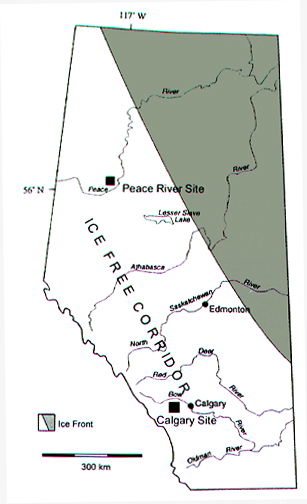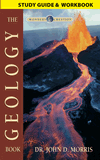
Did 'Old World Early Paleolithic' People Travel to North America?
Originally published in Journal of Creation 14, no 3 (December 2000): 3-5.
Abstract
For creationists, these reports of 'Early Paleolithic tools' raise questions that need further research.
It has been assumed that a fairly advanced Paleo-Indian culture, the Clovis people, rounded the Bering land bridge during the Ice Age and passed by land through the ice-free corridor into the United States, Central America and South America.1 Although the timing of this migration is disputed, most researchers would place this migration at about 11,000 years ago within the uniformitarian geological time scale.2
However, the above scenario is being challenged on several fronts, one of which is a report by Chlachula and Leslie of ‘Old World Early Paleolithic tools’ near Peace River and Calgary, Alberta, Canada.3,4 The ‘stone artefacts’ consist of various quartzite cobbles and flakes that presumably have been worked by man into choppers.5 Drawings of the stones show them as freshly chipped tools. But photographs show that the broken parts of the rocks have a rough, weathered look and do not even look like ‘tools.’ (Interestingly, the stone tools are usually illustrated with artistic drawings that show a man-made, fresh appearance. Photographs of the stones are rarely shown.) The ‘tools’ are similar to tools from the Lower Paleolithic industries from Pleistocene Eurasia6 and to the ‘Oldowan industry’ from the Oldovai Gorge, east-central Africa.
How strong is this evidence that Lower Paleolithic people rounded the Bering land bridge during an interglacial or interstadial7 and entered the United States? Are the ‘tools’ really human artefacts or are they geofacts (fashioned by geology)?
Artefacts or geofacts?
Chlachula and Leslie admit that some of the previously defined cultural attributes of these ‘tools’ could occasionally develop naturally on fractured quartzose rocks, especially in glacial settings.8 Yet, they dismiss this possibility because the cobbles are all of similar size, display a regularity of flaking, and are similar to other ‘tools’ found elsewhere in the world.9
Some archaeologists are skeptical that the stones are indeed ‘tools.’
Robert Young, Bruce Rains and Gerald Osborn,10 for example, are skeptical of Chlachula’s stone ‘tools.’ They believe natural agencies could have fashioned such rudimentary tools, and one of them ‘ … has seen flakes being pried off round quartzite cobbles in till [boulder clay, deposited by a glacier] northwest of Calgary by growth of gypsum crystals in hairline fractures.’11 Anthropologist Don Grayson is critical of crude stone tools in general, since such tools are found at a number of sites that are believed to be non-archaeological.12 He states that a wide variety of natural processes, such as freeze-thaw, stream tumbling, or debris flows can produce geofacts: ‘Archaeologists have long known that rocks tumbled as such fans are being formed can look much like artifacts.’ 13
Don Dumond, professor of anthropology at the University of Oregon, USA, in a letter to Science News, probably stated the thoughts of many when he commented on similar Lower Paleolithic ‘tools’ found in Siberia:
‘[The article] omits a crucial question that has plagued archaeologists at various sites for more than a century: Are those broken rocks from the Diring site demonstrably the products of human workmanship? Among my own archaeologist colleagues who have seen one or more of Mochanov’s presentations and examined his specimens, the answer is an almost universal—and resounding—negative.’ 14
The Diring Yuriakh site in Siberia, referred to by Dumond, is still believed by many to be a genuine Lower Paleolithic campground littered with stone tools. However, the ‘artefacts’ from two other sites are admitted to be geofacts.15
Chlachula and Leslie attempt to counter such skepticism:
‘Assumptions that ice can generate artefact-looking “geofacts” in large numbers reflect either a lack of familiarity with “pebble tool” stone industries and (or) a limited understanding of glacial dynamics and related ice-marginal depositional processes.’8

This may or may not be true. Regardless, the authors are assuming that the geology of the area was fashioned by uniformitarian mechanisms. Is it possible that tool-shaped stones can be fashioned by catastrophic action?
The cobbles were originally ‘fashioned’ from the preglacial coarse gravels that mantle much of the plains of southern and central Alberta, southern Saskatchewan, and north-central and northeast Montana. A few tools are found still associated with this gravel which has been clearly deposited by water. For example, the cobbles and boulders are well rounded by water action. The authors, as well as other investigators, assume these quartzite gravels were eroded from the Rocky Mountains, since quartzite outcrops widely in the mountains but not on the plains. Further, they envisage that the gravel was transported and deposited from meandering rivers. However there is a problem with this explanation. The coarse gravels are found on top of high plateaus (or erosion surfaces) up to at least 700 km from their source. They are generally in massive beds and have been violently hammered as indicated by abundant percussion marks. This is not evidence of a meandering river, but of catastrophic transport and deposition by water.16,17
Most of the ‘tools’ were found within glacial debris, which suggests that they were reworked from the preglacial gravel and glacially transported. Several of the ‘tools’ near Peace River are partly striated or fluvially abraded to some degree. It should be noted that some of the pre-glacial gravel is still in situ at both sites, implying that glacial erosion was only slight. Obviously the area could not have been covered by many ice sheets over millions of years, or the gravel would have been disturbed. The persistence of the gravel is more in line with one post-Flood short Ice Age.2,18
To complicate the situation even further, Chlachula and Leslie report that identical lithic assemblages are now found abundantly distributed across Alberta after the Ice Age! This would mean that a number of groups of people using early Paleolithic stone tools entered the New World at the same time as the Clovis people. So far no early Paleolithic ‘tools’ have been found further south in unglaciated areas. This could indicate that the stone ‘tools’ are just geological artefacts. Or it could be that archaeologists have never looked for them, since early Stone Age people were not supposed to have entered the New World.
A biblical perspective
For creationists, these reports of ‘Early Paleolithic tools’ raise questions that need further research. If the ‘tools’ are genuine human artefacts, it means that one group of people with the crudest stone tools imaginable made the long journey during the Ice Age at the same time as the sophisticated Clovis people. Alternatively, it could also mean that the same people used both very crude and sophisticated tools. Either way, this new research greatly complicates the nice, neat archaeological tool classification system in which old tools were replaced by more sophisticated tools as man supposedly evolved. There is also the question of how supposedly ‘archaic’ human beings, defined by the evolutionary scheme, could round the Bering land bridge in a cold climate. During an ‘interglacial,’ the climate would be similar to today, with very cold winters and difficult travel in summer due to boggy substrate above permafrost. If they travelled during an ice age within the uniformitarian scheme, the climate would be much colder than today.
Another possibility is that these tools are really geofacts and were formed by catastrophic action that uniformitarian geologists automatically dismiss. Strong currents flowing off the land during the Recessional stage of the Flood, or post-Flood Ice Age mechanisms, could possibly have formed the ‘tools’ in Alberta. Since the ‘tools’ found in Alberta are similar to other ‘tools’ found in Europe, Asia and Africa, these other ‘tools’ could also be geofacts. Since the Flood was global, the catastrophe of the Flood could possibly explain the chipped stones elsewhere. Also possible are local post-Flood catastrophes that could garner enough fluvial energy to fashion rounded cobbles into the form of chipped ‘tools.’
Acknowledgement
I thank Ray Strom of Calgary, Alberta, Canada, for looking over the manuscript.
References
- Fagen, B.M., The Great Journey—The Peopling of Ancient America, Thames and Hudson Ltd, London, 1987. Return to text.
- For information on the Ice Age, the Bering land bridge, and why the lowlands of Siberia, Alaska, and the Yukon would have had a mild, ice-free climate hospitable for migrating people and animals see: Oard, M.J., An Ice Age Caused by the Genesis Flood, Institute for Creation Research, Santee, California, 1990. Return to text.
- Chlachula, J. and Leslie, L., Preglacial archaeological evidences at Grimshaw, the Peace River area, Alberta, Canadian J. Earth Sciences 35:871–884, 1998. Return to text.
- Chlachula, J., Geology and Quaternary environments of the first preglacial Palaeolithic sites found in Alberta, Canada, Quaternary Science Reviews 15:285–313, 1996. Return to text.
- Choppers are rounded cobbles that have been supposedly chipped into a blunt end and a generally rounded end. Return to text.
- Chlachula, Ref. 4, p. 310. Return to text.
- Within the standard uniformitarian multiple-ice-age scheme, an interglacial is the warm time between two glacial periods (such as occurring now before the ‘next’ ice age), while an interstadial is a warm phase within one glaciation. Return to text.
- Chlachula and Leslie, Ref. 3, p. 878. Return to text.
- Chlachula and Leslie, Ref. 3, p. 876. Return to text.
- Young, R.R., Rains, R.B. and Osborn, G., Correspondence—Comments on ‘Geology and Quaternary environments of the first preglacial Palaeolithic sites found in Alberta, Canada’ by Jiri Chlachula, Quaternary Science Reviews 17:449–453, 1998. Return to text.
- Young et al., Ref. 10, p. 453. Return to text.
- Grayson, D.K., The Desert’s Past—A Natural Prehistory of the Great Basin, Smithsonian Institution Press, Washington, D.C., pp. 53, 58, 59, 1993. Return to text.
- Grayson, Ref. 12, p. 59. Return to text.
- Dumond, D.E., Rocks made by human hands? Science News 145(16):243, 1994. Return to text.
- Waters, M.R., Forman, S.L. and Pierson, J.M., Diring Yuriakh: a Lower Paleolithic site in central Siberia, Science 275:1281–1284, 1997. Return to text.
- Klevberg, P. and Oard, M.J., Paleohydrology of the Cypress Hills Formation and Flaxville Gravel; in: Walsh, R.E. (ed.), Proceedings of the Fourth International Conference on Creationism, Creation Science Fellowship, Pittsburgh, Pennsylvania, pp. 361–378, 1998. Return to text.
- Oard, M.J. and Klevberg, P., A diluvial interpretation of the Cypress Hills Formation, Flaxville Gravel, and related deposits; in: Walsh, R.E. (ed.), Proceedings of the Fourth International Conference on Creationism, Creation Science Fellowship, Pittsburgh, Pennsylvania, pp. 421–436, 1998. Return to text.
- Oard, M.J., Only one glaciation in southwest Alberta, CEN Tech. J. 9(1):4, 1995. Return to text.
For more information, see Controversy Over “Early Paleolithic” Stone “Tools” in Canada Continues.
Recommended Resources

Answers in Genesis is an apologetics ministry, dedicated to helping Christians defend their faith and proclaim the good news of Jesus Christ.
- Customer Service 800.778.3390
- © 2024 Answers in Genesis



